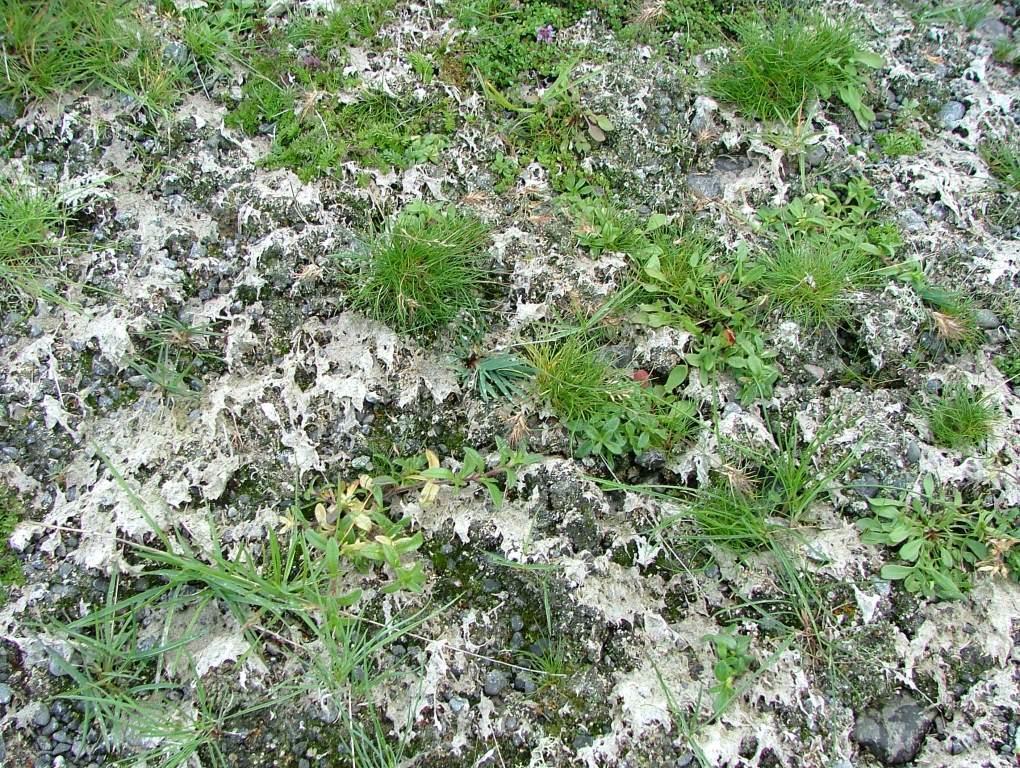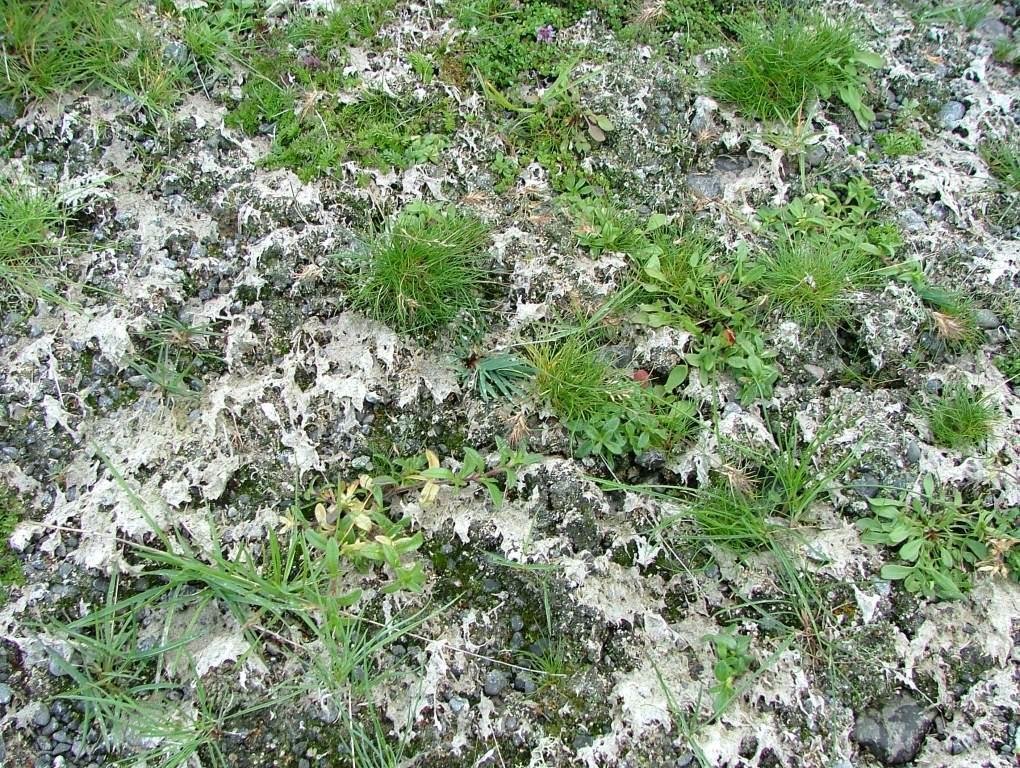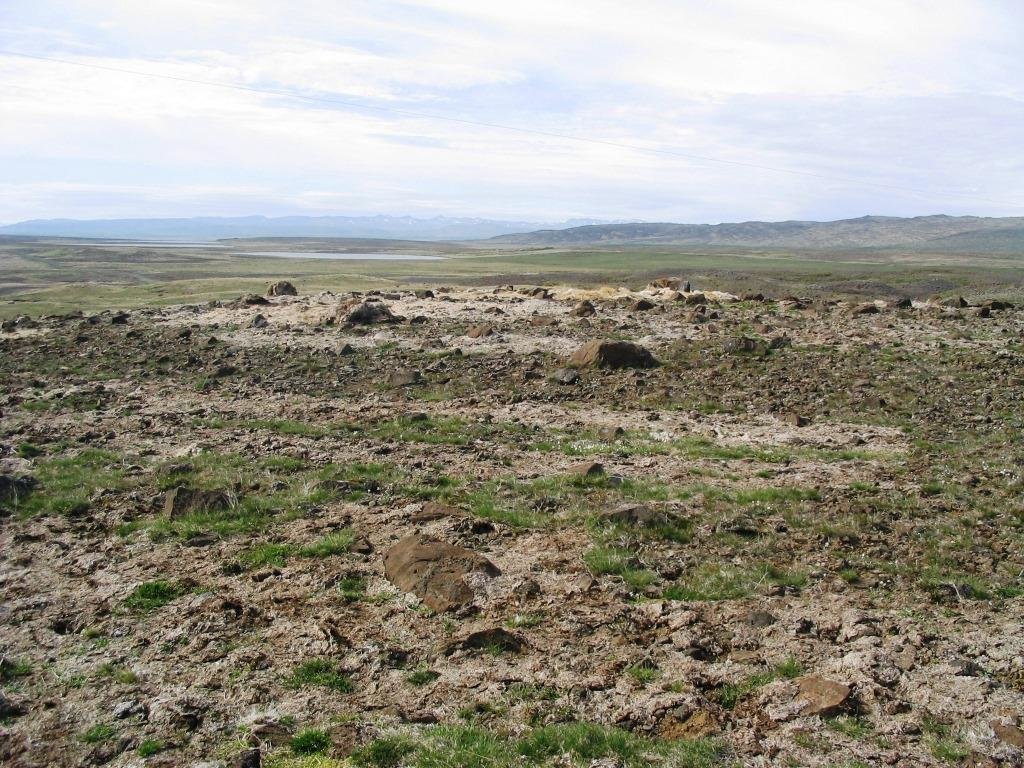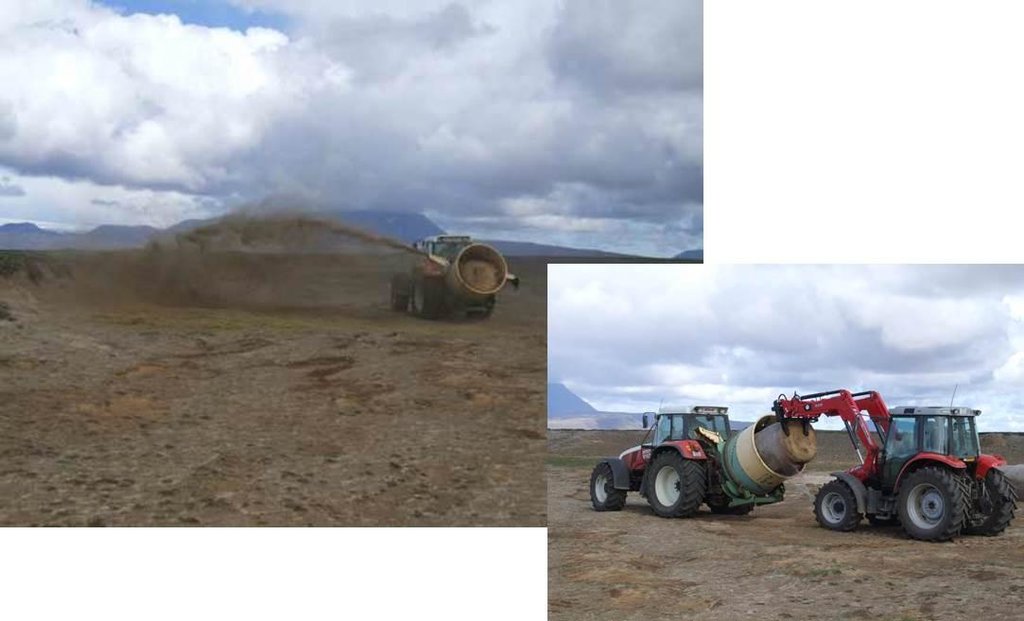Applying organic residuals on denuded areas [冰岛]
- 创建:
- 更新:
- 编制者: Thorunn Petursdottir
- 编辑者: –
- 审查者: Fabian Ottiger
Restoration with organic residuals
technologies_1761 - 冰岛
查看章节
全部展开 全部收起1. 一般信息
1.2 参与该技术评估和文件编制的资源人员和机构的联系方式
有助于对技术进行记录/评估的项目名称(如相关)
Preventing and Remediating degradation of soils in Europe through Land Care (EU-RECARE )有助于对技术进行记录/评估的机构名称(如相关)
Soil Conservation Service of Iceland (Soil Conservation Service of Iceland) - 冰岛1.3 关于使用通过WOCAT记录的数据的条件
编制者和关键资源人员接受有关使用通过WOCAT记录数据的条件。:
是
2. SLM技术的说明
2.1 技术简介
技术定义:
Applying organic residuals on denuded ares
2.2 技术的详细说明
说明:
The concerning rangelands are severely degraded and parts of them have even lost their topsoil layer entirely. Nevertheless, in many cases some remnant vegetation patches are still in place and can serve as seed banks during the restoration process. In order to stabilize the surface (i.e. to reduce the effects of freeze-thaw processes), provide nutrients to the system, increase water availability and facilitate the distribution of native species within the degraded areas, tractors are used to spread manure or hay over the denuded areas. All implementations are based on the methods and tools used in ecological restoration, aiming at re-activating environmental and ecological processes and increasing the resilience of the ecosystems undergoing restoration. Denuded patches, preferably close to the remaining vegetation "islands" are covered with organic matter in order to stabilize the surface, facilitate seed production and seed dispersal and provide safe sites for seed germination.
Purpose of the Technology: The purpose with the technology is to halt further land degradation and facilitate natural succession within the area undergoing restoration. In the long-term, it should substantially reduce wind and water erosion. It should also lead to increased biodiversity, enhanced water availability and accelerated carbon sequestration (in soil and vegetation). The overall restoration task is to increase the resilience of the ecosystems against natural hazards; such as volcanic activities.
Establishment / maintenance activities and inputs: In the year after the areas are treated, they are commonly treated with a low portion of inorganic fertilizer to add easily dissolvable nutrients to the seeds and seedling that have already germinated within the area. The fertilizing treatment is repeated approx biannually for 4-8 years on the average.
Natural / human environment: In the long-term, the technology is expected to substantially increase biomass production, re-build soil qualities, accelerate carbon sequestration and secure water availability within the rangeland and the adjacent ecosystems. The areas still grazed are expected to be more suitable for livestock grazing and the protected areas are expected to be of more recreational and aesthetic value. Increased vegetation cover will reduce and even halt the sand drift that still creates challenges for inhabitants in adjacent villages, on farmsteads and within the summerhouse clusters, scattered around the area. As the degraded rangeland is in the vicinity of an active volcano (Mt Hekla) the technology is also expected to increase ecosystem resilience against natural hazards like ash and pumice drift and reduce potential offsite damages caused by these materials.
2.3 技术照片
2.5 已应用该技术的、本评估所涵盖的国家/地区/地点
国家:
冰岛
区域/州/省:
Rangarthig Ytra
有关地点的进一步说明:
Rangarvellir
2.6 实施日期
如果不知道确切的年份,请说明大概的日期:
- 50多年前(传统)
2.7 技术介绍
详细说明该技术是如何引入的:
- 作为传统系统的一部分(> 50 年)
3. SLM技术的分类
3.1 该技术的主要目的
- 减少、预防、恢复土地退化
3.2 应用该技术的当前土地利用类型

牧场

其它
具体说明:
Wastelands, deserts, glaciers, swamps, recreation areas, etc
注释:
Major land use problems (compiler’s opinion): Vast parts of the area are heavily degraded due to unsustainable land use through the centuries in combination to harsh climate and frequent volcanic eruptions. The major land use problem are related to the fact that the concerned ecosystems collapsed long time ago and despite all restoration efforts implemented within the area for over 100 years, the systems are still highly dysfunctional. Their carrying capacity is limited and even light livestock grazing can keep further vegetation succession down. Passive restoration might take place where the livestock grazing has been excluded but in most cases some technologies are needed to "kickstart" the ecosystem and break their negative resilience against changes.
Major land use problems (land users’ perception): They are fully aware that the ecosystems are in a poor condition and restoration is needed in order to push improvements forward. They acknowledge that grazing of collapsed ecosystems can maintain the dysfunctional of the systems and hinder ecological improvements. Nevertheless, in many cases they believe the harsh climate and volcanic activities are the main contributors to land degradation - that livestock grazing and the grazing carrying capacity of the rangeland are not fundamental issues in this context.
Future (final) land use (after implementation of SLM Technology): Grazing land: Ge: Extensive grazing land
如果由于技术的实施而导致土地用途发生变化,则在技术实施前说明土地利的用途。:
Other: Oo: Other: wastelands, deserts, glaciers, swamps, recreation areas, etc
3.4 该技术所属的SLM组
- 改良的地面/植被覆盖
3.5 技术传播
注释:
Total area covered by the SLM Technology is 900 m2.
3.6 包含该技术的可持续土地管理措施

农艺措施
- A1:植被和土壤覆盖层
- A2:有机质/土壤肥力
注释:
Main measures: agronomic measures
3.7 该技术强调的主要土地退化类型

土壤水蚀
- Wt:表土流失/地表侵蚀
- Wo:场外劣化效应

土壤风蚀
- Et:表土流失
- Eo:场外劣化效应

生物性退化
- Bc:植被覆盖的减少
- Bq:数量/生物量减少
- Bs:质量和物种组成/多样性的下降

水质恶化
- Hs:地表水良变化
- Hg:地下水/含水层水位的变化
注释:
Main type of degradation addressed: Wt: loss of topsoil / surface erosion, Et: loss of topsoil, Eo: offsite degradation effects, Bc: reduction of vegetation cover
Secondary types of degradation addressed: Wo: offsite degradation effects, Bq: quantity / biomass decline, Bs: quality and species composition /diversity decline, Hs: change in quantity of surface water, Hg: change in groundwater / aquifer level
3.8 防止、减少或恢复土地退化
注释:
Main goals: prevention of land degradation, mitigation / reduction of land degradation, rehabilitation / reclamation of denuded land
4. 技术规范、实施活动、投入和成本
4.1 该技术的技术图纸
4.2 技术规范/技术图纸说明
An example of how old hay can effectively be distributed on denuded areas with the right equipment
Technical knowledge required for field staff / advisors: low
Technical knowledge required for land users: low
4.3 有关投入和成本计算的一般信息
其它/国家货币(具体说明):
ISK
注明美元与当地货币的汇率(如相关):1美元=:
112.0
4.4 技术建立活动
| 活动 | 措施类型 | 时间 | |
|---|---|---|---|
| 1. | Spreading organic residuals | 农业学的 |
4.5 技术建立所需要的费用和投入
| 对投入进行具体说明 | 单位 | 数量 | 单位成本 | 每项投入的总成本 | 土地使用者承担的成本% | |
|---|---|---|---|---|---|---|
| 设备 | Machine use | ha | 1.0 | 180.0 | 180.0 | 100.0 |
| 肥料和杀菌剂 | Compost/manure | ha | 1.0 | 42.0 | 42.0 | |
| 技术建立所需总成本 | 222.0 | |||||
注释:
Duration of establishment phase: 1 month(s)
Life span of the organic residuals: 1 year
Number of parties sharing: 232
4.8 影响成本的最重要因素
描述影响成本的最决定性因素:
The most determinate factors affecting the cost are: 1) the machinery needed and 2) the distance of the eroded areas from the farmsteads
5. 自然和人文环境
5.1 气候
年降雨量
- < 250毫米
- 251-500毫米
- 501-750毫米
- 751-1,000毫米
- 1,001-1,500毫米
- 1,501-2,000毫米
- 2,001-3,000毫米
- 3,001-4,000毫米
- > 4,000毫米
农业气候带
- 半湿润
- 半干旱
Thermal climate class: boreal
链接和模块
全部展开 全部收起链接
无链接
模块
无模块





